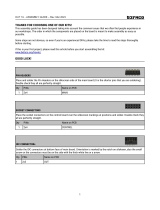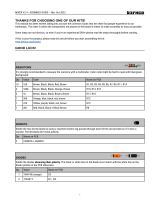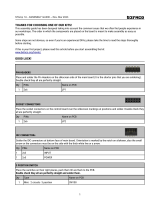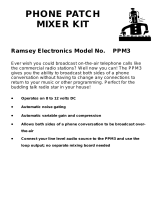
HEXMIX V1 - ASSEMBLY GUIDE Rev. Oct 2022
THANKS FOR CHOOSING ONE OF OUR KITS!
This manual has been written taking into account the common issues that we often find people experience in our
workshops. The order in which the components are placed on the board is meant to make assembly as easy as possible.
This is a quite complex build. If you are not an experienced DIYer you might find yourself in trouble. Some steps are not
obvious, and some components tricky to solder, so even if you're an experienced DIYer please read the steps thoroughly
before starting. You will be assembling both boards at the same time.
HAVE FUN!
Color code can be difficult to identify, we strongly recommend to use a multimeter.
Brown, black, black, red, brown
R2, R3, R4, R5, R6, R7, R8, R9, R10, R11, R12, R13, R14, R15,
R16, R19, R20, R21, R22, R23, R27, R28, R30, R31, R32, R42,
R54, R55, R56, R57, R58, R59, R60, R61, R79, R80, R81, R82,
R83, R84, R85, R86, R88, R89, R90, R91, R92, R93, R94, R95,
R96, R99, R106, R107, R109, R110, R116, R118, R120, R122,
R209, R210, R215, R219, R220, R221, R222, R223, R224, R225,
R226, R227, R229, R237, R238, R239, R240, R242, R243, R250,
R251, R253, R254, R255, R256, R257, R258, R259, R260, R261,
R262, R263, R264, R272, R278, R286
Brown, black, black, orange, brown
R34, R35, R36, R37, R38, R39, R40, R41, R63, R64, R65, R66,
R67, R68, R69, R70, R101, R104, R202, R203, R204, R205, R207,
R208, R265, R280, R290, R291
Brown, black, black, yellow, brown
R216, R217, R230, R231, R232, R233, R234, R235, R236, R241,
R244, R245, R246, R247, R248, R249
Blue, grey, black, brown, brown
R273, R274, R275, R276, R277, R281, R282, R283, R284, R285,
R287, R288
Brown, black, black, brown, brown
R17, R25, R44, R62, R100, R112, R200, R201
Yellow, purple, black, red, brown
R228, R252, R266, R267, R268, R269, R270, R271
Brown, green, black, orange,brown
R71, R72, R73, R74, R75, R76, R77, R78
Grey, red, black, orange, brown
R46, R47, R48, R49, R50, R51, R52, R53
Orange, orange, black, black,brown
R18, R24, R33, R43, R97, R111
Green, blue, black, brown, brown
R1, R26, R29, R45, R98, R113
Brown, red, black, red,brown
R87, R105, R114, R115, R117, R119
Orange, white, black, red, brown
R206, R211, R212, R213, R214, R218
Brown, green, black, red, brown
Yellow, purple, black,black,brown
White, brown, black, brown, brown
Orange, blue, black, red, brown
White, brown, black, red, brown
Red, red, black, orange, brown























